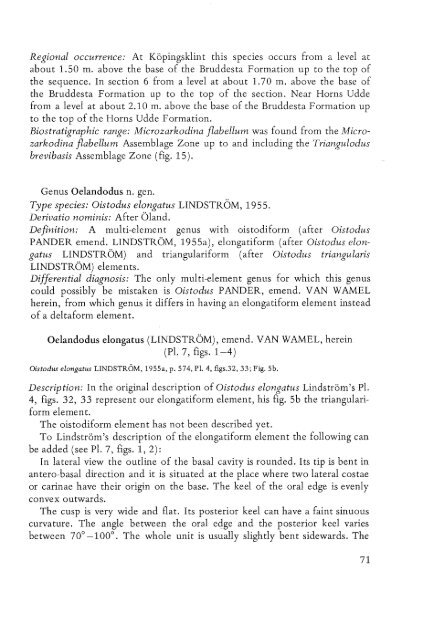UTRECHT MICROPALEONTOLOGICAL BUllETINS
UTRECHT MICROPALEONTOLOGICAL BUllETINS
UTRECHT MICROPALEONTOLOGICAL BUllETINS
Create successful ePaper yourself
Turn your PDF publications into a flip-book with our unique Google optimized e-Paper software.
Regional occurrence: At Kopingsklint this species occurs from a level at<br />
about 1.50 m. above the base of the Bruddesta Formation up to the top of<br />
the sequence. In section 6 from a level at about 1.70 m. above the base of<br />
the Bruddesta Formation up to the top of the section. Near Horns Udde<br />
from a level at about 2.10 m. above the base of the Bruddesta Formation up<br />
to the top of the Horns Udde Formation.<br />
Biostratigraphic range: Microzarkodina flabellum was found from the Microzarkodina<br />
flabellum Assemblage Zone up to and including the Triangulodus<br />
brevibasis Assemblage Zone (fig. 15).<br />
Genus oelandodus n. gen.<br />
Type species: Oistodus elongatus LINDSTROM, 1955.<br />
Derivatio nominis: After Oland.<br />
Definition: A multi-element genus with oistodiform (after Oistodus<br />
PANDER emend. LINDSTROM, 1955a), elongatiform (after Oistodus elongatus<br />
LINDSTROM) and triangulariform (after Oistodus triangularis<br />
LINDSTROM) elements.<br />
Differential diagnosis: The only multi-element genus for which this genus<br />
could possibly be mistaken is Oistodus PANDER, emend. VAN WAMEL<br />
herein, from which genus it differs in having an elongatiform element instead<br />
of a deltaform element.<br />
Oelandodus elongatus (LINDSTROM), emend. VAN WAMEL, herein<br />
(PI. 7, figs. 1-4)<br />
Description: In the original description of Oistodus elongatus Lindstrom's PI.<br />
4, figs. 32, 33 represent our elongatiform element, his fig. 5b the triangulariform<br />
element.<br />
The oistodiform element has not been described yet.<br />
To Lindstrom's description of the elongatiform element the following can<br />
be added (see PI. 7, figs. 1,2):<br />
In lateral view the outline of the basal cavity is rounded. Its tip is bent in<br />
antero-basal direction and it is situated at the place where two lateral costae<br />
or carinae have their origin on the base. The keel of the oral edge is evenly<br />
convex outwards.<br />
The cusp is very wide and flat. Its posterior keel can have a faint sinuous<br />
curvature. The angle between the oral edge and the posterior keel varies<br />
between 70 0 -100 0 • The whole unit is usually slightly bent sidewards. The
















